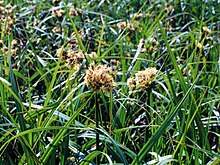Scirpus
| Scirpus | |
|---|---|
 |
|
| Scirpus atrovirens | |
| Scientific classification | |
| Kingdom: | Plantae |
| (unranked): | Angiosperms |
| (unranked): | Monocots |
| (unranked): | Commelinids |
| Order: | Poales |
| Family: | Cyperaceae |
| Genus: |
Scirpus L. |
| Species | |
|
About 120; see text |
|
| Synonyms | |
|
|
About 120; see text
Scirpus is a genus of aquatic, grass-like species in the family Cyperaceae (the sedges), many with the common names club-rush or bulrush (see also bulrush for other plant genera so-named). Other common names are deergrass or grassweed. They have grass-like leaves, and clusters of small spikelets, often brown. Some species (e.g. S. lacustris) can reach a height of 3 m, while others (e.g. S. supinus) are much smaller, only reaching 20–30 cm tall.
The genus has a nearly cosmopolitan distribution, found on every continent except Africa and Antarctica. Many species are common in wetlands and can produce dense stands of vegetation, along rivers, in coastal deltas and in ponds and potholes. Although flooding is the most important factor affecting its distribution, drought, ice scour, grazing, fire and salinity also affect its abundance. It can survive unfavourable conditions like prolonged flooding, or drought, as buried seeds
Scirpus species are often planted to inhibit soil erosion and provide habitat for other wildlife. They are also used in some herbal remedies; the plant's rhizomes are collected in the autumn and winter and dried in the sun before use.
The taxonomy of the genus is complex, and under review by botanists. Recent studies by taxonomists of the Cyperaceae have resulted in the creation of several new genera, including the genera Schoenoplectus and Bolboschoenus; others (including Blysmus, Isolepis, Nomochloa, and Scirpoides) have also been used. At one point this genus held almost 300 species, but many of the species once assigned to it have now been reassigned, and it now holds an estimated 120 species.
Scirpus species are used as food plants by the larvae of some Lepidoptera species, including Batrachedra cuniculata.
...
Wikipedia
